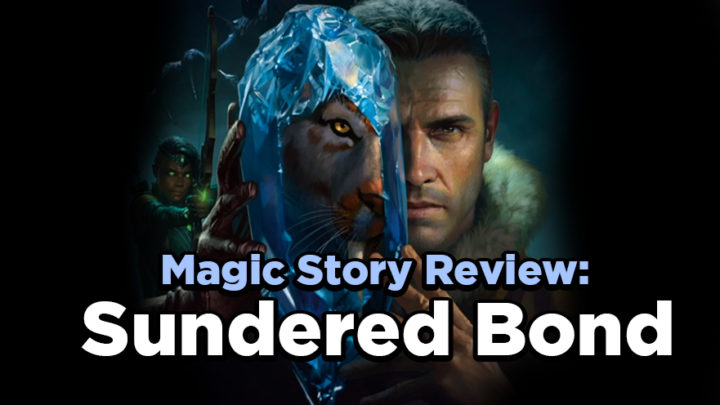(Note: This article contains spoilers for Sundered Bond.)
On the surface, Ikoria’s tagline: “There’s Always A Bigger Monster” is fairly straightforward. Life is simple: you fight for your survival, whether you’re a human fighting a monster or even a monster fighting another monster. Until he unexpectedly bonded with a giant dinosaur cat, Captain Lukka of Drannith would have agreed with that sentiment. This spontaneous connection sets off a series of events that completely upends Lukka’s understanding of the world – and, ultimately, his understanding of himself.
Django Wexler’s Sundered Bond is a delightfully subversive romp through Ikoria, cleverly twisting expectations at nearly every turn. After his successful venture into Ravnica in The Gathering Storm, it is exciting to see Wexler portray a very different plane with the same level of passion and affection. Instead of exploring an endless city, Wexler delves into the heart of Ikoria by questioning the nature of monsters, power, and humanity.

In chapter one, we learn about the rigid social structure of Drannith, the fortress-city that defends most of Ikoria’s human population. Under the martial law of General Kudro, Lukka is considered a protégé for killing dangerous monsters along with his elite Intercept Squad. His engagement to Kudro’s daughter Jirina also marks him as a rising star, which makes his bond with a dinosaur cat that much more jarring. Facing death for his connection with monsters, Kudro flees Drannith with Jirina’s help and encounters other “bonders” like himself. Along with Vivien Reid, Lukka and his fellow bonders investigate what magic is compelling monsters to attack human settlements, tracing it back to the Ozolith. It is then that Lukka makes a decision that will impact the entire plane and change his life forever.
Like Ikoria itself, Wexler’s decision to start off this narrative with Lukka seems deceptively simple. Our hero is a promising young white man who, with the help of his friends and his trusty steed, will vanquish unjust hierarchies put in place by his unenlightened elders. What is so clever about this initial set-up is how deftly Wexler flips our expectations by slowly inserting Jirina’s perspective. This way, Lukka and Jirina become foils of one another, each embodying a competing philosophy of how to balance this world of humans versus monsters.

Jirina is a highly pragmatic black woman. While she may not have as much tactical experience as Lukka, she trained under her father to learn the strategy of Drannith’s existence. Observant, intuitive and compassionate, Jirina understands the shades of grey that comprise her world. If anything, Jirina’s greatest strength is her love for Lukka, a love that keeps her mind open to new experiences, ideas and growth. It is this empathy that allows her to compromise and innovate.
In the final siege of Drannith, Jirina’s ability to unite the different strengths of humans, monsters and bonders is what makes her vision of Ikoria’s future triumphant. This idea of a united force of outcasts and misfits led by a powerful black woman is incredibly progressive. In contrast, Lukka’s acceptance of the Ozolith’s simple “conquer them all” mentality with his nightmare army is shattered, causing Lukka to spark and planeswalk away.
Unfortunately, Lukka’s shift from “hero” to “villain” seems rushed, especially after we see him open up readily to the other bonders and monsters after fleeing Drannith. While the Ozolith’s seduction of Lukka happens quickly, Wexler’s decision to change Lukka is understandable. Despite his new life, Lukka seeks the comfort of living in an “us vs. them” world; the execution of his companion by General Kudro forces him to accept that power without thinking of the consequences. Perhaps this is simply a shortcoming of the novella form, but it would have been nice to witness a more gradual corruption of his character.
While Vivien Reid has a consistent presence throughout the novella, Wexler’s decision to keep the focus on Jirina and Lukka makes for a more compelling story. Vivien doesn’t have the same investment in this struggle as the native Ikorians, and allowing the reader to connect fully with them keeps the narrative tension high. Narset is briefly mentioned, but doesn’t make an appearance; Wexler keeps the focus on a few fleshed-out characters and avoids the “too many characters, not enough plot” we saw in Wiesman’s War of the Spark.
Though distinctly shorter than The Gathering Storm, Sundered Bond provides powerful insights on what truly makes a monster. In the end, it’s not size, strength, venomous fangs or razor-sharp talons that make something monstrous. It’s a rigid adherence to a moral binary that leaves no room for empathy, compassion, and adaptation.

A consummate lover of books, tea, food and instant-speed kill spells, Michelle is a person of many passions. Her hobbies include cuddling cats, throwing pottery, and analyzing Magic lore from a literary perspective. She is also a co-host of the Vorthos comedy podcast, “The Loregoyfs,” and she comprises a full 25% of The Felidar Guardian (specifically the right hand, left ear and both scapulas). Her CMC is 2BWU, and her ETB trigger creates two 1/1 cats with lifelink and trample.

